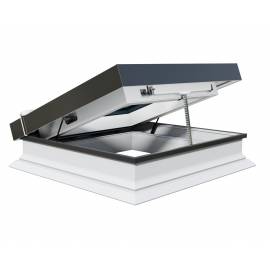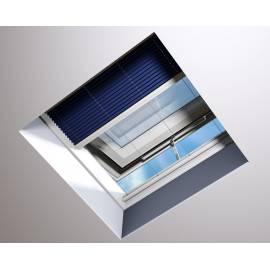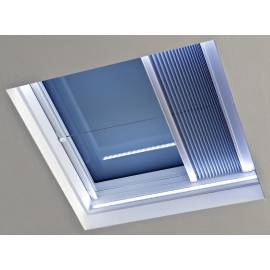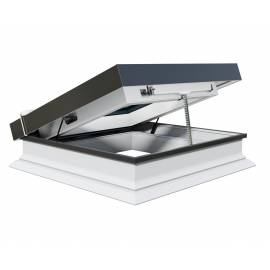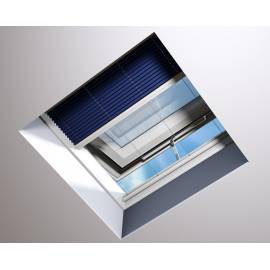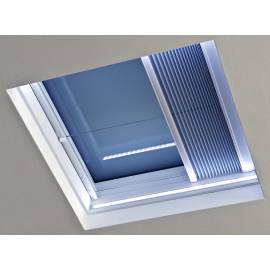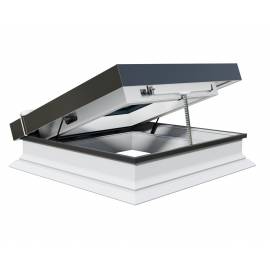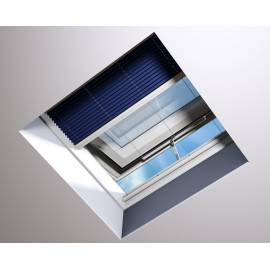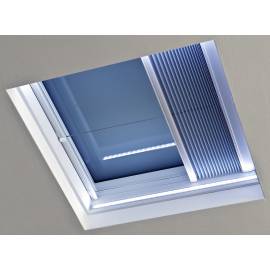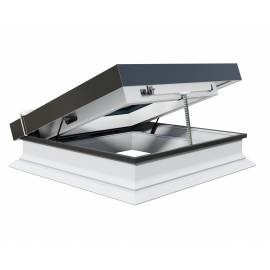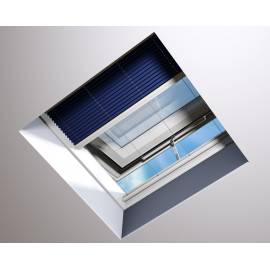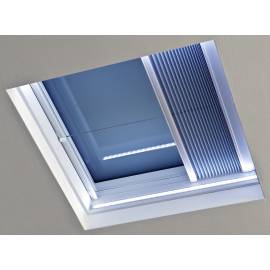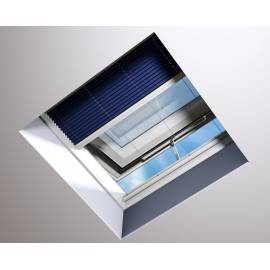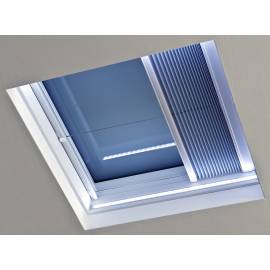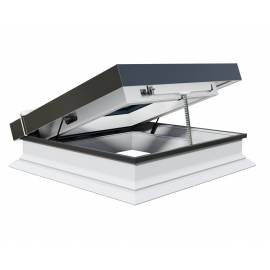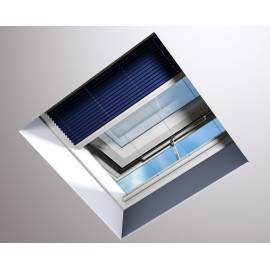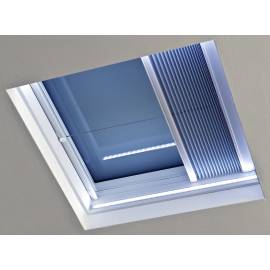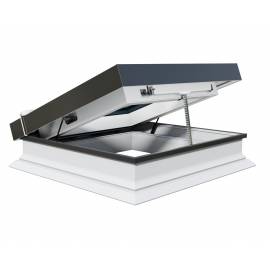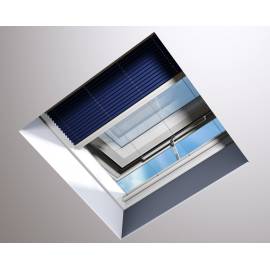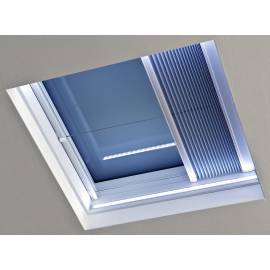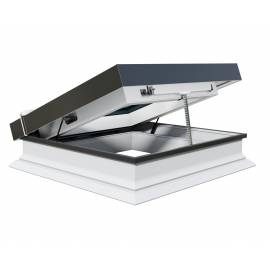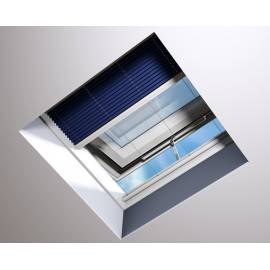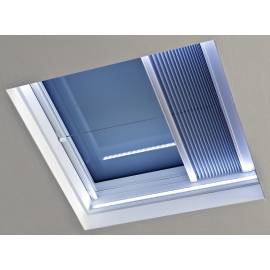Use the filters
Electric Hinged Flat Glass Rooflights
While both fixed and openable flat roof windows, also commonly referred to as rooflights, are designed specifically for flat roofs that range in pitch from 0 to 15 degrees to provide as much natural daylight into your house as possible, openable roof windows have one significant advantage - they can be opened for venting. As a homeowner, you can choose from electric to manually operated flat roof windows.
-
Flat Roof Window PGC A1 Electric 60cm x 60cm Flat Glass Rooflight Electric Opening Double Glazed Flat Roof Window PGC A1 Electric 60cm x 60cm Flat Glass Rooflight Electric Opening...
Product Features Automatic Rain Sensor: Automatically closes the window when rain is detected, ensuring no water ingress. High Energy Efficiency: Boasts a U value of Uw=1.2 W/m²K for the window and Ug=1.0 W/m²K for the glazing, reducing energy costs. Easy Installation: Comes fully assembled and can be installed on roofs with a minimum pitch of 2°,... Product Features Automatic Rain...
£ 935.00
£ 779.17 ex. VAT1 Review(s)In Stock -
Flat Roof Window PGC A1 Electric 60cm x 90cm Flat Glass Rooflight Electric Opening Double Glazed Flat Roof Window PGC A1 Electric 60cm x 90cm Flat Glass Rooflight Electric Opening...
Product Features Automatic Rain Sensor: Window automatically closes when rain is detected, ensuring protection from water ingress. Highly Energy Efficient: With a window U-value of Uw = 1.2 W/m²K and glazing U-value of Ug = 1.0 W/m²K, it provides excellent insulation and energy savings. Durable and Maintenance-Free: Made from multi-chambered,... Product Features Automatic Rain...
£ 975.00
£ 812.50 ex. VATIn Stock -
Flat Roof Window PGC A1 Electric 80cm x 80cm Flat Glass Rooflight Electric Opening Double Glazed Flat Roof Window PGC A1 Electric 80cm x 80cm Flat Glass Rooflight Electric Opening...
Product Features Electric Opening with Rain Sensor: Automatically closes when rain is detected, ensuring protection from weather conditions. Highly Energy Efficient: Features a Uw value of 1.2 W/m²K, reducing energy consumption and enhancing insulation. Durable and Maintenance-Free: Constructed from multi-chambered PVC, resistant to mist, freezing,... Product Features Electric Opening...
£ 1,015.00
£ 845.83 ex. VAT1 Review(s)Delivery FREE 20 - 25 working days * -
Flat Roof Window PGC A1 Electric 60cm x 120cm Flat Glass Rooflight Electric Opening Double Glazed Flat Roof Window PGC A1 Electric 60cm x 120cm Flat Glass Rooflight Electric Opening...
Product Features Remote-Controlled Electric Opening: Easily opens up to 20 cm, ideal for ventilation in humid rooms like kitchens and bathrooms. Rain Sensor Technology: Automatically closes the window when rain is detected, preventing water ingress. Energy Efficiency: Features a highly energy-efficient glazing unit with a Uw value of 1.2 W/m²K,... Product Features Remote-Controlled...
£ 1,055.00
£ 879.17 ex. VAT1 Review(s)Delivery FREE 20 - 25 working days * -
Flat Roof Window PGC A1 Electric 90cm x 90cm Flat Glass Rooflight Electric Opening Double Glazed Flat Roof Window PGC A1 Electric 90cm x 90cm Flat Glass Rooflight Electric Opening...
Product Features Highly Energy Efficient: Features a Uw value of 1.2 W/m²K, reducing heat loss and saving on energy bills. Weather Resistant and Durable: Made from multi-chambered, maintenance-free PVC, resistant to mist, freezing, dew, and humidity. Advanced Functionality: Equipped with an electric opening mechanism, remote control, and a rain... Product Features Highly Energy...
£ 1,070.00
£ 891.67 ex. VAT1 Review(s)In Stock -
Flat Roof Window PGC A1 Electric 100cm x 100cm Flat Glass Rooflight Electric Opening Double Glazed Flat Roof Window PGC A1 Electric 100cm x 100cm Flat Glass Rooflight Electric Opening...
Product Features Energy Efficient: Highly energy-efficient with a Uw value of 1.2 W/m²K and glazing Ug value of 1.0 W/m²K, reducing heating costs. Convenient Operation: Electric opening mechanism with remote control and rain sensor for automatic closure during rain. Durable and Weather-Resistant: Made from water-resistant PVC, resistant to mist,... Product Features Energy Efficient:...
£ 1,175.00
£ 979.17 ex. VAT1 Review(s)Delivery FREE 20 - 25 working days * -
Flat Roof Window PGC A1 Electric 90cm x 120cm Flat Glass Rooflight Electric Opening Double Glazed Flat Roof Window PGC A1 Electric 90cm x 120cm Flat Glass Rooflight Electric Opening...
Product Features Electric Opening with Rain Sensor: Automatically closes the window when rain is detected, ensuring protection from weather conditions. Highly Energy Efficient: Features a window U-value of Uw = 1.2 W/m²K and glazing U-value of Ug = 1.0 W/m²K, promoting energy savings. Durable and Maintenance-Free Construction: Made from... Product Features Electric Opening...
£ 1,185.00
£ 987.50 ex. VAT1 Review(s)Delivery FREE 20 - 25 working days * -
Flat Roof Window PGC A1 Electric 100cm x 150cm Flat Glass Rooflight Electric Opening Double Glazed Flat Roof Window PGC A1 Electric 100cm x 150cm Flat Glass Rooflight Electric Opening...
Product Features 10-Year Warranty: Ensures long-term reliability and peace of mind for the window. Highly Energy Efficient: With a Uw value of 1.2 W/m²K, this window helps reduce energy consumption. Rain Sensor Equipped: Automatically closes the window when rain is detected for added convenience and protection. Easy Installation: Fully assembled and... Product Features 10-Year Warranty:...
£ 1,375.00
£ 1,145.83 ex. VAT1 Review(s)Delivery FREE 20-25 working days *
Sunlux electric hinged flat glass rooflights have been specifically designed to maximize the airflow and natural lighting inside your house. If you have been looking for a way to brighten up your interiors and allow for more ambience inside of your house, installing a flat roof window that will serve you for years to come is an excellent idea.
The electric features of the hinged flat glass rooflights make the windows much easier to operate, and they remain highly energy efficient. It is the technology of the future, and once most homeowners experience it for the first time, they can’t do without it.
Read moreBenefits of Electric Roof Windows
Even though electric flat roof skylights and windows are still a relatively new invention, they continue to grow in popularity. When looked at from above or below, they appear flat, which adds to the aesthetic of a whole building, but, in fact, they're installed at a slight slope or can also be domed.
A flat rooflight is a modern and energy-efficient solution, perfect for a brand new build or a house that's being remodeled and needs some extra illumination. If you want to let lots of light into any of your rooms, you can pick and choose from a wide range of different roof windows until you find something that fits your needs best.
FAQ
ℹ️ Can you have a window on a flat roof?
Yes, you can safely install a flat roof window to let more natural light into your house. In most cases, there's no need to apply for any special permission as long as you follow building regulations, but keep in mind that in the end, everything depends on the particular product you chose for your project.
For instance, custom roof lights may require you to stay in contact with your local planning authority, but, in general, installing flat roof windows isn't the most demanding process, especially if you're working with skilled professionals.
ℹ️ What are the different types of roof windows?
When it comes to flat roof windows, there's a wide product range that differs in price. This means that you can browse our offer until you find something that suits all your needs and preferences and falls in your preferred price range.
Depending on your needs and a room's purpose, you can choose from various types of windows suitable for a flat roof. They range from fixed flat glass rooflights, roof domes sun tunnels, and roof lanterns to electric or manual-opening rooflights, as well as polycarbonate options.
ℹ️ What type of flat roof window is the best?
It all depends on your individual needs and preferences.
Fixed flat roof windows are incredibly popular among homeowners who want a sleek and modern design that's also affordable. If ventilation isn't your primary concern, they work particularly well when installed in areas such as staircases. They do not open, so their main purpose is to let in more daylight rather than allow you to air out the room.
Roof domes' stand out from the crowd because their glazing is made of polycarbonate instead of glass. The glazing itself is dome-shaped, but the domes can be pyramid, square, rectangular, or circular. They provide both ventilation and lots of daylight and are really affordable.
Sun tunnels channel sunlight from the roof through a reflective tube to let in more natural light. They're a perfect addition to your flat roof if you need to illuminate a windowless corridor, a north-facing room, or a dark garage.
Roof lanterns are often favored among other types of flat roof windows for their ability to channel light from virtually all angles and the fact that they look stunningly beautiful in any interior.
If you're looking for an inexpensive way to let in more light into any area of your house, opting for a fixed flat roof window will be enough. On the other hand, if you want to be able to ventilate the area, you should choose an openable flat roof window. For the most comfort, choose an electric flat roof window that you can operate via remote control.
ℹ️ How much does it cost to add an electric flat roof window?
Sunlux electric flat roof window, which can also be interchangeably called a flat glass rooflight, costs anywhere from around £800 to £1250, depending on the particular model you choose and factors such as size, glazing options, and frame materials.
Even though the price may seem quite high at first, it's important to keep in mind that an electric flat glass rooflight is a worthwhile investment that will serve you well for years and remain a cost-effective solution, especially when the electricity prices continue to rise.
ℹ️ How do you clean an electric flat roof window?
Cleaning an electric flat glass rooflight doesn't need to be a hassle. In most cases, all you need is to open your window and stand on a ladder or a stool that allows you to reach the window. Then, you can clean the pane using a soft, lint-free cloth, clean water, and a non-abrasive window cleaner of your choice. It's also a good idea to have a squeegee on hand so you can have a smudge-free window.
If you don't want to deal with cleaning your flat glass rooflight yourself, you can always hire a professional to do it for you or consider paying extra for self-cleaning glass.
ℹ️ Do you need planning permission for an electric flat roof window?
Permitted Development (PD) rights allow you to install roof windows as long as they do not project more than 150mm from the roof plane.
However, you should be aware of several exceptions. If your property is located in a conservation area or is currently listed, you will need to obtain planning permission before installing a roof window.
Checking with your local planning authority before starting the installation process is a good starting point. It's the best way to figure out whether or not you need planning permission for your specific project.





